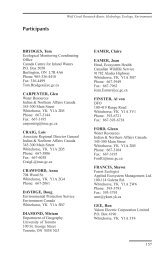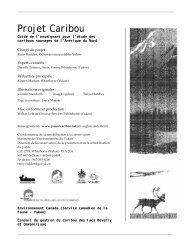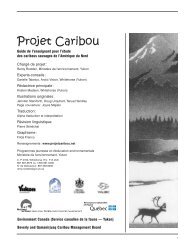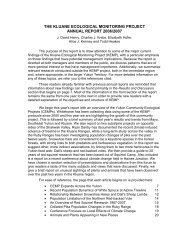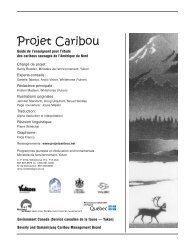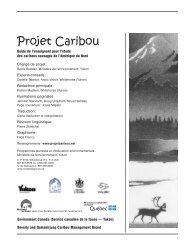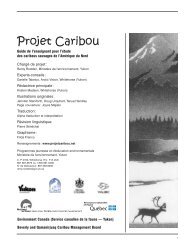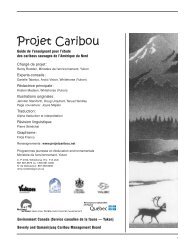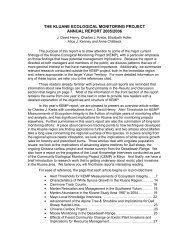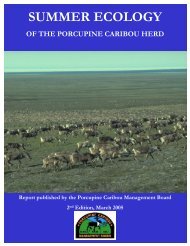Caribou Trails newsletter Spring 2007 - Taiga Net
Caribou Trails newsletter Spring 2007 - Taiga Net
Caribou Trails newsletter Spring 2007 - Taiga Net
Create successful ePaper yourself
Turn your PDF publications into a flip-book with our unique Google optimized e-Paper software.
~<br />
Ruby Ayaqin Foster<br />
Around my time there were no caribou. We just ate fi sh,<br />
ptarmigan and rabbit. � at is all. � ere were no caribou around<br />
during that time–absolutely none. � ere was no moose and not<br />
much bear during that time too. I even used to go pick berries by<br />
myself or nasriqsruuraaq. I was not afraid. � ere was nothing to<br />
fear from black bears or brown bears - there were none of these.<br />
Maybe around 1954-55, and I am guessing, the caribou started<br />
coming here. I followed my husband up to Kuugruaq area in<br />
the 1950s. It is way out from Ambler. We went by dog team. I<br />
would lead with snowshoes. I was carrying at that time. When<br />
we get tired, someone else leads (sivulliqsruq). It is long ways, and<br />
Ambler is quite a distance from here (Selawik).<br />
“One wonders<br />
about those who<br />
lived in other<br />
places and time<br />
before us, and<br />
how they did it.”<br />
we used the stomach as bag to put the innards in.<br />
I think we were gone for a month up there. We had<br />
no groceries or naluagmiutaq (white people’s food)<br />
then. We had to share when we get anything<br />
like moose, caribou or rabbit. � e ones who<br />
had hunters share with the widows like me<br />
(presently). It wasn’t easy<br />
–qaganangitchuq–to hunt<br />
for caribou then.<br />
We spent the winter upriver<br />
in sod houses. We and old<br />
women used to set snares.<br />
I used to check traps and<br />
snares above Niliq with a<br />
dog team. One wonders<br />
about those who lived<br />
in other places and time<br />
before us, and how they<br />
did it. � e ones before us<br />
starved when they had<br />
no food.<br />
Ruby Foster,<br />
Roy Smith<br />
& Johnny<br />
Norton<br />
our elders speak<br />
“What is given in the right way<br />
cannot be forgotten.”<br />
� ey get as much caribou<br />
as a person is able to—and<br />
they don’t leave anything<br />
like right now. � ey brought<br />
home the skins, feet parts,<br />
and head. Today, the head<br />
or caribou feet are not taken<br />
home. � e heart, liver,<br />
tunusrisaq, and kivviq were<br />
taken home. � e only thing<br />
they left was<br />
the stomach<br />
contents, and<br />
—David Greist, Selawik Elder<br />
A continuing series of interviews with Selawik Elders<br />
Johnny mikiana Norton<br />
We also hunted at Arguurangani or below Salliagutchiich hills, or<br />
around Angmanauraq (a pass in the Rabbit Mountains). It was<br />
one days worth of traveling from Selawik to Rabbit Mountain by<br />
dog team when it uvluqtusri—or had more day light in spring. If<br />
you went to Kiana, you spent<br />
the night in Kiana. And then<br />
spent another night and then go<br />
again.<br />
We used heavy rifl es in those<br />
days; 30-30 and 25-35. � ey<br />
also used 303 Remington with<br />
no scope. Sometime one would<br />
not take any caribou home.<br />
Most of the time one can take a<br />
sledload home.<br />
You had to use somebody else to<br />
go move the herd, and someone<br />
would hide while the other<br />
person drove them to them. � e<br />
people hiding would shoot them<br />
� at was how they hunted a long time ago.<br />
“� e elders<br />
worked together<br />
in the past.<br />
When we<br />
followed the<br />
elder men; that<br />
was how they<br />
made us hunt.”<br />
Today, our young people don’t do that now. It is fi rst come, fi rst<br />
served. � e elders worked together in the past. When we followed<br />
the elder men; that was how they made us hunt. Together, they<br />
worked as a team.<br />
Ralph Ayyatungaq<br />
Raymoth, Sr.<br />
Long time ago, before the white man, some tribes<br />
were living around the Kobuk River area. � ey<br />
would scatter and move seasonally. In August or<br />
September they traveled north to hunt for caribou<br />
camp. My mom used to talk about our<br />
grandfather that he used to go hunt out<br />
to the Brooks Range.<br />
� ere was a ridge the caribou<br />
followed. � e people piled up<br />
the rocks to make them look<br />
like humans. Some people<br />
were behind the caribou<br />
and drove them down<br />
that ridge to the lake.<br />
� e people would be<br />
waiting there with<br />
their canoes. � ey killed<br />
the caribou with spears<br />
while they were crossing the



